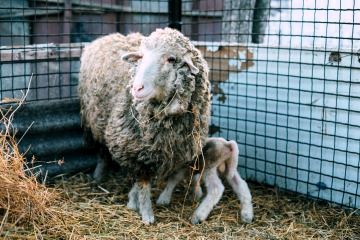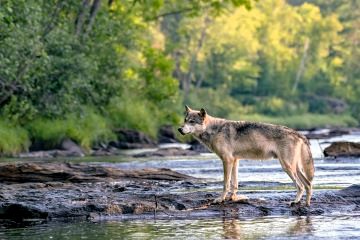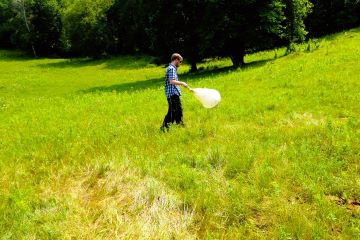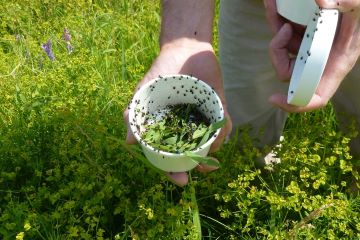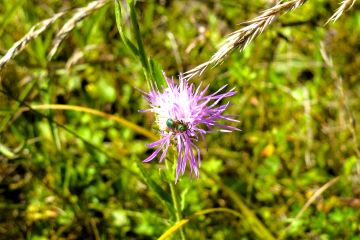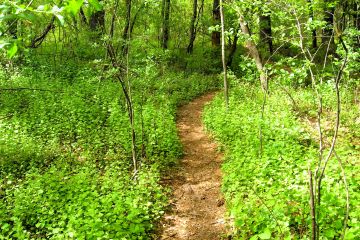The Minnesota Department of Agriculture (MDA) is preparing to aerially manage seven sites in Fillmore, Houston, and Winona counties to slow the spread of spongy moth. Officials will likely conduct the aerial management activities July 1-3, beginning as early as 6:30 a.m. and continuing throughout the day. These dates are dependent on weather conditions in the area.
This operation was originally scheduled for mid-June, however due to federal budget uncertainties and delays the operation was pushed back to early July.
The seven sites total approximately 28,907 acres. Maps of the sites are available on the MDA website. Residents can also look up their address on an interactive map to determine if they are within any of these blocks. Two of the sites include Minnesota State Parks, Whitewater and Beaver Creek Valley.
The MDA will use a method of mating disruption which is the aerial application of a non-toxic waxy, food-grade substance containing pheromones specific to spongy moths that confuse the male moths. This makes it difficult for the male spongy moths to find females, reducing mating success. The result is fewer caterpillars hatching and attacking trees next year.
The mating disruption product will be applied by low-flying yellow planes contracted by the United States Department of Agriculture’s Forest Service in a joint project with the MDA. The product is not harmful to humans, animals, birds, or other insects, and will help protect forest health, property values, and the state’s tourism industry.
To help area citizens stay informed, the MDA has set up a Report a Pest Info Line at 1-888-545-6684 with the latest details about treatment dates and times. On the morning of the treatments, residents can call the phone number with any questions they may have. Simply press 0 (zero) to speak to someone. The MDA's website also has information about spongy moths and control efforts.
Residents can also sign up for text or email updates about treatment progress. On the Spongy Moth Treatment Map you can click each area (outlined in blue) you would like to receive updates for, follow the “sign up for text or email notification” link.
Spongy moths are among America's most destructive tree pests, having caused millions of dollars in damage to eastern forests. The moths are now threatening Minnesota. If present in large numbers, spongy moth caterpillars can defoliate large sections of forest. Oak, poplar, birch, and willow are among their preferred hosts. The moths spread slowly on their own, but people can unintentionally help them spread by transporting firewood or other items on which the moths have laid their eggs.
Contact the Minnesota Department of Agriculture at 1-888-545-6684 or reportapest@state.mn.us with questions regarding spongy moth and the planned treatment.
###
Media Contact
Brittany Raveill, MDA Communications
651-201-6131
Brittany.Raveill@state.mn.us
The Minnesota Department of Agriculture (MDA) has confirmed emerald ash borer (EAB) in multiple new locations. EAB was confirmed in new areas of Carlton County and was found for the first time in Meeker, Murray, Ottertail, and Wadena counties. There are now 58 counties in the state with EAB.
Where EAB was recently confirmed:
| County | Location | Discovery Details |
|---|---|---|
| Carlton | Rural Carlton County near Holyoke, Sawyer, and Wrenshall | EAB was discovered by a Minnesota Department of Natural Resources employee. |
| Meeker | Round Lake public access south of Litchfield | EAB was discovered by a Meeker County Soil and Water Conservation District Employee. |
| Murray | West of the City of Fulda | EAB was discovered by a Murray County Soil and Water Conservation District Employee. |
| Ottertail | Town of Deer Creek | The MDA confirmed an EAB find submitted by a tree care company. |
| Wadena | City of Wadena | The MDA confirmed an EAB find submitted by a tree care company. |
What is EAB:
EAB was first discovered in Minnesota in 2009. The insect larvae kill ash trees by tunneling under the bark and feeding on the part of the tree that moves nutrients up and down the trunk. Often, the trees show several signs of infestation because of this. Woodpeckers like to feed on EAB larvae, and woodpecker holes may indicate the presence of emerald ash borer. Also, EAB tunneling can cause the bark to split open, revealing characteristic S-shaped galleries underneath.
Quarantine information:
The MDA is enacting emergency quarantines in Carlton, Meeker, Murray, Ottertail, and Wadena counties. All of Carlton County, excluding the Fond du Lac Reservation, will be quarantined. The entire counties of Meeker, Murray, Ottertail, and Wadena will be quarantined. The quarantines limit the movement of firewood and ash material out of the area.
The MDA issues quarantines for all areas known to have EAB to reduce the risk of further spreading the tree-killing insect.
More information:
A virtual informational meeting for residents and tree care professionals will be held on Tuesday, July 8, from 10–11 a.m. Experts from the MDA will give a brief presentation followed by a question-and-answer session. Register on the MDA website.
The public will also have an opportunity to provide input on the emergency quarantines before the quarantines become formal. The MDA is taking comments on the emergency quarantine now through August 8, 2025, and recommends adopting the quarantine on August 11, 2025. The proposed quarantine language can be found at the MDA website.
Comments can be made during the virtual meeting or by contacting:
Mark Abrahamson
Minnesota Department of Agriculture
625 Robert Street North
St. Paul, MN 55155
Mark.Abrahamson@state.mn.us
There is more EAB information on the MDA website.
###
Media Contact
Brittany Raveill, MDA Communications
651-201-6131
Brittany.Raveill@state.mn.us
A new grant program from the Minnesota Department of Agriculture (MDA) created to help new farmers with the cost of purchasing needed equipment and infrastructure has awarded 97 grants totaling $856,833 across 45 Minnesota counties in its first year.
Demand for the Beginning Farmer Equipment and Infrastructure Grant far outstripped legislative funding for the grant, with 1,100 eligible applicants requesting $18.6 million from the grant program.
“Minnesota needs its next generation of farmers to thrive, and reducing the hurdles that prevent beginning farmers from becoming profitable is key to that effort,” MDA Assistant Commissioner Patrice Bailey said. “Besides securing land, getting the necessary farming equipment and infrastructure is a huge hurdle.”
Awardees were selected through a competitive process in which applications were evaluated by a review committee based on criteria shared in the Request for Proposals.
Individual awards of up to $20,000 are reimbursing a wide variety of equipment and infrastructure purchase costs for different types of farming, including:
- Fencing for 16 applicants
- Specialty crop equipment for 15 applicants
- Tractor purchases for 11 applicants, from small walk-behind tractors to larger row crop tractors
- Livestock chute systems for nine applicants, plus livestock equipment including feeding and watering systems for others
- Water access improvements and irrigation equipment for eight applicants
- New infrastructure projects such as high tunnels, equipment storage structures, and walk-in coolers
- Improvements for existing infrastructure such as barns and feed lots
- Various other needs, including a soybean head, GPS technology for tractors, bee hives, a grain transfer system, hay balers, and Christmas tree farm equipment
Qualified applicants were required to be:
- A beginning farmer
- A Minnesota resident
- Farming within the borders of the state of Minnesota
- In good standing with the state of Minnesota
###
Media Contact
Larry Schumacher, MDA Communications
651-201-6629
Larry.Schumacher@state.mn.us
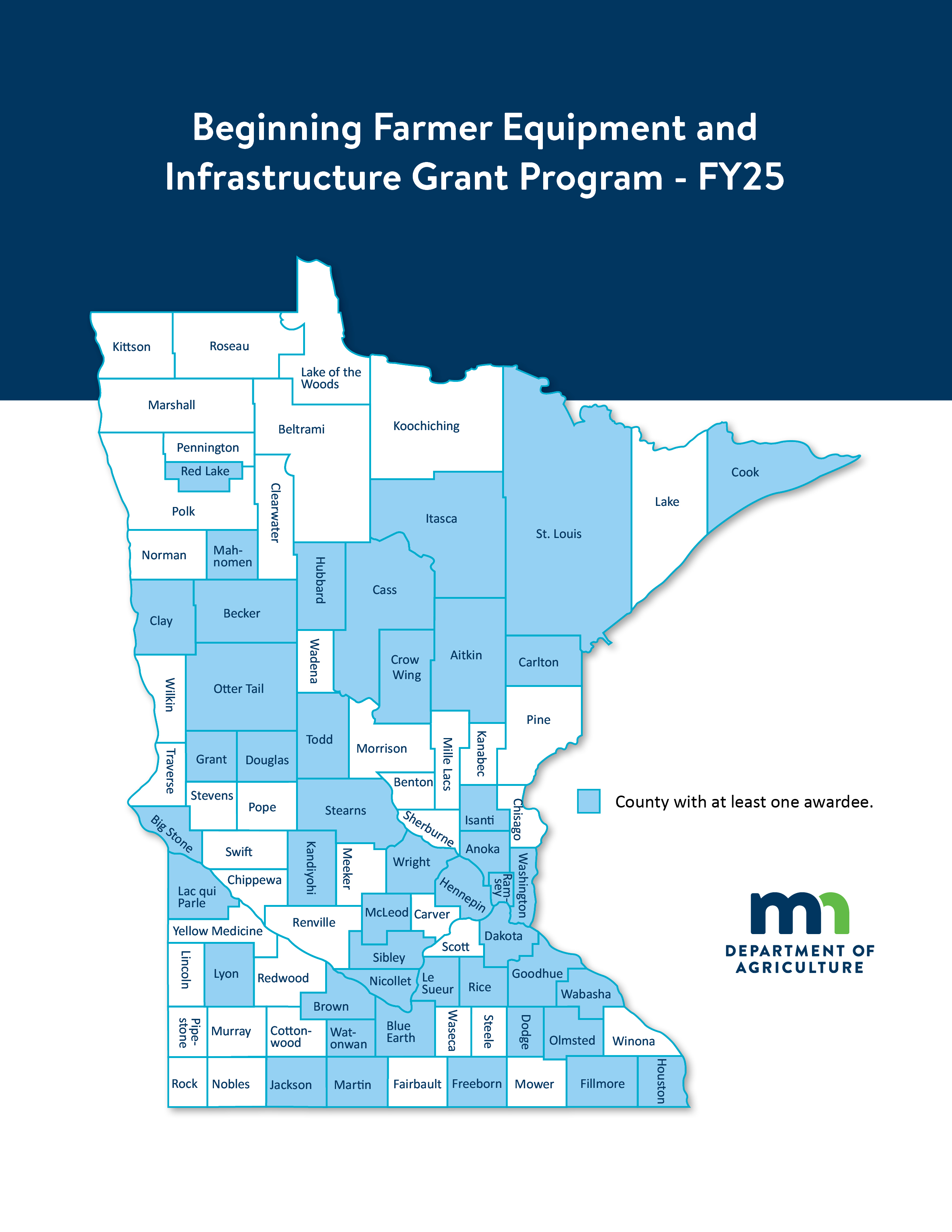
Tri-County Livestock Auction
32638 U.S. Hwy 10
Motley, MN 56466
MDA's outreach veterinarian will have a booth at the Special Feeder Sale for the Tri-County Stockyards. Stop by to say hello and pick up some resources on drug residue prevention. The sale starts at 10, but we will be there early and stay through the end of the sale!
The Minnesota Department of Agriculture (MDA) is preparing to aerially manage 24 sites in Aitkin, Carlton, Itasca, Pine, and St. Louis counties to slow the spread of spongy moth, a destructive invasive forest pest. Officials will likely conduct the aerial management activities July 16-22, beginning as early as 6:30 a.m. and continuing throughout the day. These dates are dependent on weather conditions in the area.
The 24 sites total approximately 83,760 acres. A map of the sites is available on the MDA website. Residents can also look up their address on an interactive map to determine if they are within any of these areas.
The MDA will use a method of mating disruption which uses the aerial application of a non-toxic waxy, food-grade substance containing pheromones specific to spongy moths that confuse the male moths. This makes it difficult for the male spongy moths to find females, reducing mating success. The result is fewer caterpillars hatching and attacking trees next year.
The mating disruption product will be applied by low-flying yellow planes contracted by the United States Department of Agriculture’s Forest Service in a joint project with the MDA. The product is not harmful to humans, animals, birds, or other insects, and will help protect forest health, property values, and the state’s tourism industry.
Unlike other spongy moth treatments that have been delayed or cut due to federal government funding, this treatment is able to move forward as scheduled. The MDA continues to monitor how federal funding decisions impact our ability to manage spongy moth across the state.
To help area citizens stay informed, the MDA has set up a Report a Pest Info Line at 1-888-545-6684 with the latest details about aerial management dates and times. On the morning of the application, residents can call the phone number with any questions they may have. Simply press 0 (zero) to speak to someone. The MDA's website also has information about spongy moths and control efforts.
Residents can also sign up for text or email updates about aerial management progress. On the Spongy Moth Map you can click each area (outlined in blue) you would like to receive updates for, then follow the “sign up for text or email notification” link.
Spongy moths are among America's most destructive tree pests, having caused millions of dollars in damage to eastern forests. The moths are now threatening Minnesota. If present in large numbers, spongy moth caterpillars can defoliate large sections of forest. Oak, poplar, birch, and willow are among their preferred hosts. The moths spread slowly on their own, but people can unintentionally help them spread to new areas by transporting firewood or other items on which the moths have laid their eggs.
Contact the Minnesota Department of Agriculture at 1-888-545-6684 or reportapest@state.mn.us with questions regarding spongy moth and the planned management activities.
###
Media Contact
Brittany Raveill, MDA Communications
651-201-6131
Brittany.Raveill@state.mn.us

